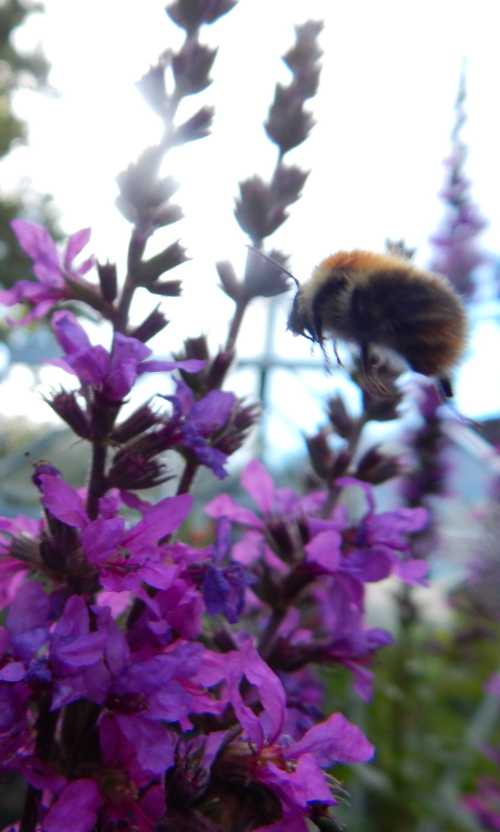Do Bumble Bees Hover?
Where insects and birds are concerned, to hover means to hang fluttering in the air by rapidly moving the wings.
A number of insects are well known for the behaviour of hovering, not least of course, the hover flies, but also for example, dragon flies and bee flies such as Bombylius major, a parasite of solitary and bumble bee species.
So what about bumble bees - do bumble bees hover?
The short answer is:
Yes, bumble bees are known to hover momentarily around flowers, and research confirms the potential of one species to hover at high elevations.
Do Bumble bees hover?
Many bee species hover at least momentarily, and especially, this behaviour can be spotted as they approach flowers. However, some bee species engage in hovering behaviour more than others. For example, wool carder bee males can often be seen patrolling patches of flowers whilst they await females. During these patrols, it is not unusual to see them hovering momentarily before darting in another direction, or darting at a female to mate.
On many occasions, I have witnessed bumble bees hovering for a second or two around flowers.
So given that bumble bees do indeed hover, are they any good at it, and what does the research say?

Study using a 'model' bumble bee
Scientists in China at the Beijing University of Aeronautics & Astronautics created a model bumble bee to study and measure bumble bee flight dynamics (1). The model had wings 'approximately' the same size and shape as those on real bumble bees.
They concluded that bumble bees are less stable when they hover or fly slowly, than when they fly fast. This would seem to suggest that hovering is not a particular strength for bumble bees. How this research would compare using data gathered from real bumble bees studying exactly this issue, is unclear.
A study of alpine bumble bees, Bombus impetuosus
A study published by the Royal Society, examined the flight performance of the alpine bumble bee, Bombus impetuosus. They found that this species of bumble bee is able to hover at conditions and height comparable with Mount Everest. The scientists remark that many insect taxa have been captured terrestrially at 5000–5200m in the Himalayas, including fly species. Butterflies have been captured in the Himalayas near 6000 m, and one of the authors of the study has observed bumble bees nesting at heights of above 4000m.
For the study, the scientists captured male specimens in Sichuan, China. They comment:
"Here, we demonstrate that alpine bumble-bees possess substantial aerodynamic reserves, and can sustain hovering flight under hypobaria [low ambient air pressure] at effective elevations in excess of 9000 m, i.e. higher than Mt. Everest. Modulation of stroke amplitude and not wingbeat frequency is the primary means of compensation for overcoming the aerodynamic challenge. The presence of such excess capacity in a high-altitude bumble-bee is surprising and suggests intermittent behavioural demands for extreme flight performance supplemental to routine foraging.
Some of their specific findings and comments were as follows:
- On average, bees were capable of hovering at air pressure equivalents exceeding 8000 m.
- Three of the bees flew above 8000 m, and two flew at air pressures corresponding to altitudes higher than the peak of Mt. Everest.
- Among individual bees, maximum flight altitude was not influenced by body mass or by air temperature, but marginally increased with relative thoracic mass. The two highest fliers (flying 9089 m and 9125 m) had relatively large thoraces (approx. 36% of body mass) compared with other bees (with values approx. 31%).
- Under hypobaric conditions, bumble-bees increased stroke amplitude (angle of wing stroke compared to the body) by approximately 20°. The maximum stroke amplitudes obtained for bumble-bee wing movement was 145–150°.
- Whether worker bumble-bees (females) are capable of similarly high elevation flights is unknown. They comment that females have smaller wings relative to body size which could limit flight capacity at extreme elevations.
References
1. Na Xu, Mao Sun. Lateral dynamic flight stability of a model bumblebee in hovering and forward flight. Journal of Theoretical Biology, 2013; 319:102 DOI: 10.1016/j.jtbi.2012.11.033
2. Dillon ME, Dudley R. Surpassing Mt. Everest: extreme flight performance of alpine bumble-bees. Biol Lett. 2014 Feb 5;10(2):20130922. doi: 10.1098/rsbl.2013.0922. PMID: 24501268; PMCID: PMC3949368.
If you found this page helpful or interesting, I'd really be grateful if you would share it with others - if not this page, perhaps another, such as Gardening For Bees.
Thank you so much :) .